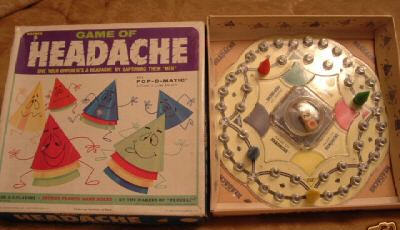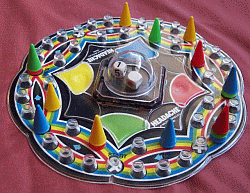Pachisi
Ludo
Parcheesi
Parques
Parchis
Patolli
Chaupar
Other
About
Links
|
|
Other
Chinesenspiel
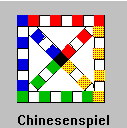 A
nineteenth-century German game probably older than many western Pachisi
variants. "The Chinamen's game". A children's game. The Europeans (and
the Germans) were somewhat obsessed with the Far East and it resulted
in this game inspired by India (Pachisi) and China (the figures). Can
be played by two, three or four people. A
nineteenth-century German game probably older than many western Pachisi
variants. "The Chinamen's game". A children's game. The Europeans (and
the Germans) were somewhat obsessed with the Far East and it resulted
in this game inspired by India (Pachisi) and China (the figures). Can
be played by two, three or four people.
Played on a deformed cross-and-circle board into a
squared perimeter connected at the four corners by two crossing
diagonals. Each player has one of the four Chinese figures (in red, green, blue and yellow). The figure starts in
the matching colored square. 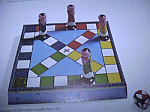
The cubic dice has two
white sides and the four rest of the colors
mentioned above. If you roll your own color you advance one piece and
can throe again. Throw an opponent's color and your turn is over. If
you throw White you can throw again. It takes 28 steps to get round,
and five to reach Home at the central intersection.
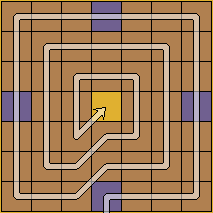 Ashte
kashte Ashte
kashte
Ashte-kashte is a race board game for two to four
players originating in India. It is the direct ancestor of Pachisi. It
is played on a board with a 7-by-7 grid on it.
Players race their pieces around the board, spiralling inwards to be
the first to get all of their pieces to the centre. Movement is
controlled by throwing cowrie shells, but there is also an element of
strategy to the game.
Equipment
The board is a square divided into seven rows and columns. The outer
centre squares on each side of the board are specially marked. They are
the starting squares for each player, and also function as resting
squares. Each player has four pieces.
Four cowrie shells are used as dice. They are thrown and the number of
shells that lie with their openings upwards indicates the number of
spaces a player should move:
Openings
upwards
Movement
4
4
3
3
2
2
1
1
none
8 |

|
Play
Players begin with no pieces on the board. A pieces may enter the board
on any throw of the cowries and moves to the square corresponding to
the throw. Each player starts on their own starting square and moves
around the board in an anticlockwise spiral. The paths of each player
are different because each player starts on a different square and
moves inwards at a different position on the board.
A player can capture an opponent's piece by landing their piece upon
it. The captured piece is removed from the board and must start again.
A piece cannot land on an opponent's piece that is on a resting square.
If a player lands their piece on another of their own pieces, it
becomes a double. Doubles cannot be passed over by single pieces
(whether the player's or the opponent's), and they can only be captured
by other doubles. In addition, the two pieces that make up the double
may be moved together.
The end (centre square) can only be reached by a direct throw. If a
player throws a number larger than that needed to reach the end, they
must move another piece or wait till their next turn.
Source:
Wikipedia article as of 01.01.2006
The
Wikipedia
article included on this page is licensed under the GNU
Free Documentation License (GFDL)
Aggravation
(1962)
| Aggravation is the name of one of the many
Pachisi variants. Its distinctive features are that the track is
usually asterisk-shaped, to accommodate six players, that it is
normally drilled to accept colored glass marbles as playing pieces, and
that it incorporates "shortcuts." There are no "safe" holes where a
player's marbles cannot be captured (or "aggravated," in the game's
parlance). |

Image from Central Connector (a complete rule
set also available)
|
Each player rolls a single die to determine the
number of spaces to move, with a roll of either 1 or 6 needed to enter
the track.
Each of the inside corners near the center of the board is a
"shortcut," as is a hole in the center of the board: if a player lands
a marble on one of the corner shortcuts, he or she has the option, on
the next roll, of jumping from shortcut to shortcut, counting each jump
as a single space; however, to do so, the player must be able to
complete the move without leaving the shortcuts. If a player on a
corner shortcut rolls a 1, he or she has the additional option of
jumping to the center shortcut; from there, the marble can move
directly to any corner shortcut on a roll of 1, but cannot move at all
on any other roll.
Source:
Wikipedia article as of 01.01.2006
The Wikipedia
article included on this page is licensed under the GNU
Free Documentation License (GFLD)
HeadAche (1968)
Another Pachisi variant, from 1968, for 2 to 4 players.
Automatic, just press the bubble and your dice numbers roll up.
 - complete rules - complete rules
|

|
BEERchesi:
Play your regular game of Pachisi,
Parcheesi or Ludo. Have a lot of beer available. If you get sent back,
or cannot move, take a drink. It's that easy. |


|
Printed sources:
- Parlett, David: The
Oxford history of Board Games, Oxford
University Press, 1999. ISBN: 0-19-212998-8
Online sources:
Acanomas -
Enciclopedia - Juegos de Mesa y Azar - El Chinesenspiel (In Spanish)
|
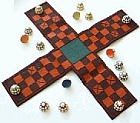
 A
nineteenth-century German game probably older than many western Pachisi
variants. "The Chinamen's game". A children's game. The Europeans (and
the Germans) were somewhat obsessed with the Far East and it resulted
in this game inspired by India (Pachisi) and China (the figures). Can
be played by two, three or four people.
A
nineteenth-century German game probably older than many western Pachisi
variants. "The Chinamen's game". A children's game. The Europeans (and
the Germans) were somewhat obsessed with the Far East and it resulted
in this game inspired by India (Pachisi) and China (the figures). Can
be played by two, three or four people.
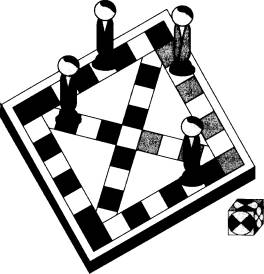
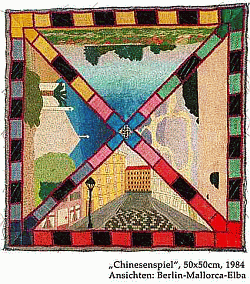
 Ashte
kashte
Ashte
kashte

